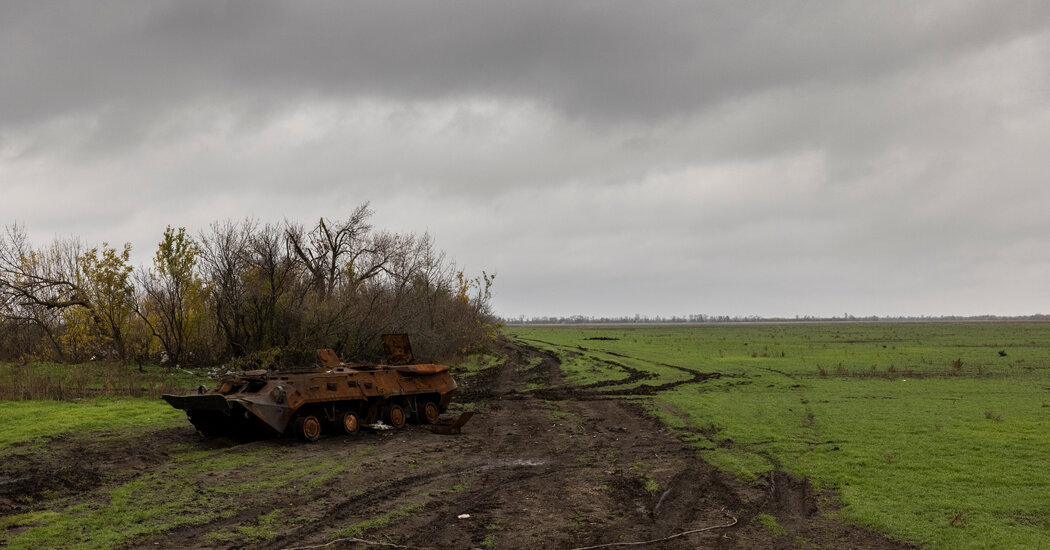
KYIV, Ukraine — While the Ukrainian march to reclaim lost land has been slowed by autumn mud, Kyiv’s forces continued to press their advance in the south, attack hastily established Russian defensive lines in the northeast and defend against a grinding monthslong assault in the Donetsk region.
Both armies are now dealing with the challenges posed by the thick clay sludge that hindered Napoleon’s army in 1812, slowed Hitler’s advance on the eastern front in 1941 and wreaked havoc on Russia’s plans for a lightning advance into Ukraine in the spring of this year.
Twice a year — during the autumn rains and again in the spring during the winter thaw — roads in Ukraine can be swallowed in slop, and fighting vehicles caught in the morass can find themselves vulnerable to enemy fire.
There is an old Russian word for the muddy seasons, “rasputitsa,” and the Ukrainians call it “bezdorizhzhya,” both essentially meaning “lack of roads.” And without roads, as Ukraine’s defense minister, Oleksiy Reznikov, told reporters this week, the Ukrainian advance will move slower.
“This is the rainy season, and it’s very difficult to use fighting carrier vehicles with wheels,” he said.
Despite the adverse weather, battles raged as Ukraine sought to surround the important city of Kreminna, in the Luhansk region of eastern Ukraine, which was captured by the Russians in April. If the Ukrainians can retake Kreminna, they can compromise a vital Russian logistical artery used to supply units in Luhansk as well as in the northern part of the neighboring region of Donetsk.
Russian military bloggers released video footage of Moscow’s forces employing TOS-1 thermobaric multiple launch rocket systems to slow the Ukrainian advance. The Institute for the Study of War, a Washington-based research organization, said the use of the powerful system could indicate either that the Russians are prioritizing the area “or that Russian forces lack sufficient artillery systems or ammunition more appropriate for standard fire missions.”
The Ukrainian military governor of the Luhansk region, Serhiy Haidai, underscored the challenges for its forces in the area, noting that heavy rains had complicated the ability to move equipment, and that since the swift advance of Ukrainian forces across northeastern Ukraine in September, the Russians have had time to bring reserves, damage bridges and further mine the territory as they fortified defensive positions.
Farther south, in the Donetsk region, Russian forces continued their frontal assaults on the battered city of Bakhmut, where they have failed to gain significant ground despite months of daily bombardments on military and civilian targets.
President Volodymyr Zelensky of Ukraine said this week that fighting around the town was some of the heaviest in the war.
“The craziness of the Russian command is now most visible there: Day after day for months, they drive people there to death, concentrate the maximum power of artillery strikes there,” he said.
Military analysts have said the town — which had a prewar population of 70,000 — holds only minimal strategic value and that the Russian efforts there are better explained by the competition among disparate elements of the Russian military.
The Bakhmut offensive is being led by fighters from the Wagner mercenary group, and its founder, Yevgeny V. Prigozhin, has been seeking a higher profile as the military effort has floundered.
In Kherson, a largely agricultural area where wide open plains are crisscrossed with irrigation canals, the wet weather has made conditions particularly difficult. While the mud is slowing the Ukrainian advance, ill-prepared Russian soldiers also are suffering. The Ukrainian military high command said on Friday that “the lack of warm clothes” had led to widespread “theft and looting” by Russian soldiers.
The Ukrainians also have sought to exploit weak morale among the Russian ranks. The Ukrainian military defense intelligence agency has released a steady stream of intercepted communications between Russian soldiers complaining about the grim conditions. The Ukrainian military said on Friday that “the unsatisfactory state of military equipment” had led to “unique cases of desertion and surrender.” Those claims could not be independently verified.



